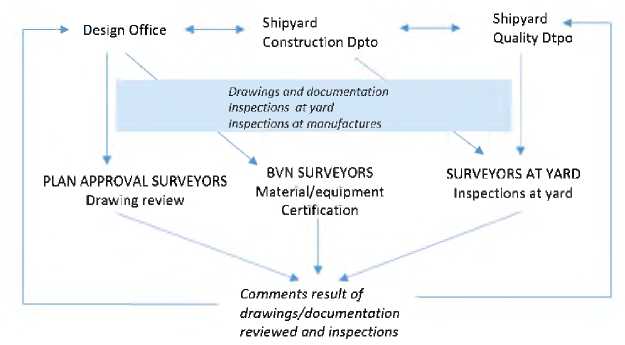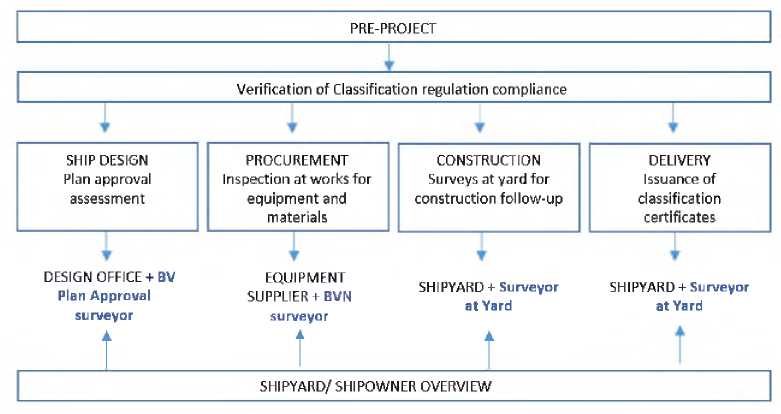
Ship Science & Technology - Vol. 17 - n.° 34 - (9-16) January 2024 - Cartagena (Colombia)
DOI: https://doi.org/10.25043/19098642.245
Lina Suárez 1
1 Bureau Veritas - Marine & Offshore, New Construction Management. Paris, France. Email: lina.suarez@bureauveritas.com
Date Received: October 14th, 2022 - Fecha de recepción: 14 de octubre 2022
Date Accepted: February 10th, 2023 - Fecha de aceptación: 10 de febrero de 2023
The Quality Management System (QMS) of a shipyard is considered as a dynamic system which ameliorates in parallel with the evolution of the shipyard, having as purpose to optimize construction performance, to reduce risks, costs and time. The interaction and participation with external organizations play an important role in the cycle processes of maintenance and improvement of the Shipyard QMS. Bureau Veritas (BV) being a Ship Classification Society, contributes to the certification process through compliance with regard to BV technical rules and statutory requirements for each ship configuration. This paper illustrates the importance of the interaction between shipyard and class society starting at early design phase until delivery of the ship. Process described is based on specifics BV rules and New Building procedures which are continuously updated based on new international regulations, experiences, researches and developments. The pre-project process is founded on the definition of the scope of work, a thorough review of the contract, familiarization with the shipyard s facilities, and the definition and agreement of all activities to be addressed throughout the entire construction. The construction process unfolds according to the agreements outlined during the pre-project phase. This part is specifically concentrated on Design Review (drawings and documents), Documentation System (procedures and methods), the Verification System (monitoring, control &reporting, witnessing, inspection 8c test), and the Management System (but not limited to); all of which are managed under a specific BV IT Tool. The result of all this is an efficient classification process that ensures ships remain safe, compliant, efficient, and environmentally friendly throughout their operating life.
Keywords: Quality Management System, Ship Classification Society, Classification rules
El Sistema de Gestión de la Calidad (SGC) de un astillero se considera como un sistema dinámico que mejora simultáneamente con la evolución del astillero, y cuyo objetivo es optimizar la ejecución de la construcción, reducir los riesgos, los costos y tiempos. La interacción y participación conjunta con organizaciones externas también desempeñan un papel importante en los procesos del ciclo de mantenimiento y la mejora del SGC del Astillero. Bureau Veritas (BV) en su papel como Sociedad de Clasificación, contribuye al proceso de certificación mediante el cumplimiento de las normas técnicas propias y los requisitos legales para cada configuración de barco. Este artículo refleja la importancia de la relación mutua entre el astillero y la sociedad de clasificación desde la fase inicial de diseño hasta la entrega del barco. El proceso descrito se basa en la normativa de BV y procedimientos de nuevas construcciones las cuales se actualizan apoyados en nuevas normativas internacionales, experiencias, investigaciones y desarrollo. El proceso de anteproyecto se basa en la definición del alcance del trabajo, la revisión del contrato, la familiarización con las instalaciones del Astillero, la definición y el acuerdo frente a todas las actividades que se abordarán durante el proceso de construcción. Dicho proceso se realiza según los acuerdos enumerados durante el anteproyecto y se focaliza en la revisión del diseño (planos y documentos), el sistema de documentación (procedimientos y métodos), el sistema de verificación (monitoreo, control e informes, observación, inspección y actividades de pruebas) y el Sistema de Gestión (sin limitación a lo mencionado anteriormente); todo se gestiona utilizando una herramienta informática propia de BV que ha sido desarrollada para este propósito. El resultado, es un proceso eficaz de clasificación que mantiene a los barcos seguros, conformes a las normas, eficientes y respetuosos con el medio ambiente durante la totalidad de su vida operativa.
Palabras claves: Sistema de Gestión de la Calidad, Sociedad de Clasificación de Buques, Reglas de clasificación.
The Quality Management System in a shipyard has the primary objective of achieving a zero-defect rate through the definition of processes, including controls, records, validations, measurements, analysis, monitoring, and improvements. This makes the QMS an integral part of a strategy to enhance market position and customer satisfaction.
The quality process must be established using standard procedures and methods, which need to be consistently followed throughout the entire process of the physical product, such as the construction of the ship.
Such a process must include targets related to the limits of acceptance for each specific process. The system's control involves documentation such as construction procedures, fabrication drawings, technical analysis reports, weight control reports, subcontractor documents, and as-built documentation, among others.
Quality records encompass contract reviews, drawings, procedures, inspection and test records, verification records, pre-commissioning, calibration records, material and equipment certificates, non-conformities, commissioning dossiers, among others.
The validation process in production includes monitoring or verification of welder certification, welding procedures, welding machines, welding consumables, NDT operator certification, NDT plan, and NDT reports, among others.
Measurement analysis and improvement aim to demonstrate the conformity of the quality management system and the quality of the product. This involves a quality audit plan, control of non-conformities, management reporting, corrective actions necessary to improve the system, and client feedback.
This article aims to emphasize the importance of defining, planning, and reaching agreements at an early stage by integrating all the mentioned activities and ensuring continuous follow-up within cross-functional processes during construction. This approach is based on the extensive knowledge and experience in high-quality standards gained since 1828 in the shipping industry.
The classification process involves the definition of rules, guidance notes, and other relevant documents for a ship, taking into account its structure, material, machinery, equipment, and other components contributing to its definition.
This process includes the review of plans/ documents, calculations, surveys, checks, verification, validations, witnessing, and tests intended to demonstrate that the ship complies with the BV rules and applicable statutory requirements.
For Bureau Veritas, the key to achieving the classification process in new construction is to identify and agree with the client on the scope of work. It is essential to possess a comprehensive understanding of the shipyard's capacities and to reach consensus on every activity to be followed during the construction, as illustrated in Fig. 1.
Fig. 1.Workflow at pre-project phase between Bureau Veritas and Shipyard.
The class notations establish the framework upon which the ship's classification is founded. They reference specific rule requirements that must be adhered to for their assignment. Class notations are specifically allocated based on the ship's type, service, operating area, and other criteria outlined by the interested party when applying for classification.
The types of class notations to be assigned to a ship are as follows:
It is the technical contract between the shipyard and the classification society. This document identifies the client's inquiry and outlines key items to initiate the classification process.
This document is prepared to familiarize with the shipyard's production facilities, management processes, and safety considerations. During this initial approach, BV aims to understand the shipyard's capability to meet contractual requirements before initiating any new construction. The following items need to be considered: Detail of any management systems : ISO standards or others
(certification, traceability, supervision, maintenance of qualification).
Once the scope of work is defined, and shipyard facilities are known by BV, discussions with the shipbuilder regarding specific activities are crucial before commencing the construction. The Kickoff meeting is divided into two parts: general aspects and hull construction. To prepare and agree on activities during the construction, each item mentioned below is to be discussed, including description, agreement, remark/conclusion, followup, and due dates, as far as applicable.
General aspects contain:
• Description or detail of agreements between shipyard and BV
The second part contains specific activities of the hull construction survey. The purpose is to discuss in detail with the Shipyard QA-QC team, requirements and the principle of Patrol surveys performance. Each item mentioned below need to be discussed including survey requirement and survey method, BV rules, statutory requirements (if any), relevant references, documentation available to the surveyor during the construction, documentation for the ship construction file, specific activities and BV proposals for the project as far as applicable.
The project is created in a BV IT Tool called Veristar Project Management (VPM). This tool is utilized throughout the entire construction process and is accessible to internal and external stakeholders such as shipyards, designers, product suppliers, and the owner, as long as it is permitted by the client.
The purpose of the tool is to assist with the management of the project throughout every activity required for construction until delivery. This tool has been developed in compliance with the BV Quality system, design approval, and established new construction procedures.
All VPM users are provided with general information about the project, stakeholders, the follow-up of plan approval assessments, the follow-up of equipment and material certification processes, the follow-up of construction surveys, submission of drawings, and the option to reply online to comments issued during the plan approval process or construction survey, as illustrated in Fig. 2.
Fig. 2.Workflow during design and construction phase using VPM.

The tool it is divided in four main parts:
Plan approval office (s) initiate drawing/ documentation review of the ship itself but also to the specific equipment. As result two type of comments can be created:
Additionally, some parallel projects are created in the same VPM tool based on material and equipment certifications as identified at the Kickoff Meeting (KoM). These projects are linked to the main ship project to provide a complete overview of the certification process. The tool allows users to see the status of the process and whether any comments need to be addressed by plan approval surveyors, BVN surveyors, yard surveyors, or from the client side.
Regarding inspections at the yard, a tree is created in VPM based on the marks and notations defined, and data input available in the system at the signature of Classification Request. It can be modified if needed based on the complexity of the project or other factors. This tree lists every scheduled and unscheduled item to be inspected, trials to be performed, and quality documentation to be recorded.
VPM includes different spaces to maintain traceability of the main items to be monitored, verified, validated, witnessed, inspected and tested as far as agreed during the pre-project process at KoM. Moreover, VPM inform BV NC Team when quality documentation is missing prior to specific milestone dates. Missing documentation may be linked but not limited to shipyard review record, Kick off meeting, welding procedures specification, welding qualifications, NDT records, patrol plan agreed, sea/river quay trials procedure, reminders to client about pending comments, etc.
Prior to delivery of the project, two last process are performed by the BV Project Leader and validated by the new Construction local manager. Process consist to review that all required drawings have been received and reviewed, all material and equipment certificates are received, all quality documentation is received and none pending comments.
In case of outstanding point remains, agreed solution between client and BV is to be specified. Such process allow to go through the following phase, Issuance of Classification Certificate.
With proper recommendation or memoranda (if applicable) in accordance with those agreement indicated during the first phase.
1. Ionel Danul SAVU, New concept of quality management in shipbuilding. Advanced Engineering Forum Vol 13, pp 332-340 (2015)
2. IACS Homepage, Unified requirements URZ23 Rev 7. https://iacs.org.uk ,last accessed 2022/11/20.
3. Bureau Veritas, Internal Procedures for New Construction Building Version 3.12 (April 2022)
4. Abdulaziz A Bubshait, ISO 9000 Quality standards in Construction. Journal of Management in Engineering (1999)